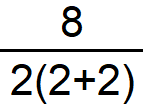greenimi
Mechanical
- Nov 30, 2011
- 2,374
3DDave and Burunduk,
Probably you won't agree with each other on what is the "correct" result of
8:2(2+2)
I am not taking sides just curious of your answers, if you will.
Is it 1?
Is it 16?
Probably that's why PEMDAS exist in the first place.
Probably you won't agree with each other on what is the "correct" result of
8:2(2+2)
I am not taking sides just curious of your answers, if you will.
Is it 1?
Is it 16?
Probably that's why PEMDAS exist in the first place.
Burunduk and 3DDave said:"Failing to understand the general principle of multiplication vs. addition" is indicated when someone suggests that the solution of 2 X 3 can be thought to be 5 only because 2 + 3 equals 5.
Understanding what is multiplication, and how there is no multiplication without addition, is when someone gets the idea that the solution for 2 multiplied by 3 is the sum of 2 added to 2 and then another 2 added. Unfortunately, some don't get even this simple concept. They should finally learn what they should have in elementary school, like basic math operations and stuff like what an analogy is (to understand how an analogy that demonstrates an idea related to a topic is drawn by bringing an example from a different topic).

![[smile] [smile] [smile]](/data/assets/smilies/smile.gif)
